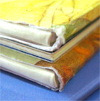|
|
|
|
|
|
|

| 최근 이 책을 구매하신 다른 회원의 책장 |
|
 |
|
|
|
[ 책 소개 ]
* British Book Award 수상작
영어 문장에서 콤마가 얼마나 중요한 역할을 하는지를 만화풍의 재미있는 그림과 함께 총 13개의 Situation 문장으로 보여줍니다.
예를 들면,
The student, said the teacher, is crazy. (선생님이 말씀하시기를 그 학생은 미쳤다)
The student said the teacher is crazy. (그 학생이 말하기를 선생님은 미쳤다)
위의 문장에는 콤마가 사용되었으나 아래 문장에는 콤마가 없습니다. 이에 따라 두 문장의 뜻은 정반대가 됩니다.
이렇듯 영어 문장에서 중요한 역할을 하는 콤마의 사용법을 재미있는 그림과 문장들을 통해 확실하게 배울 수 있습니다.
튼튼한 | 닫기x |  What is 하드커버? What is 하드커버?
양장본이라고도 불리우며, 표지가 단단한 판지로 만들어진 책입니다.
판지를 천이나 가죽으로 감싸기도 합니다. 책의 속지는 일반적으로 중성처리된 종이(Acid-free paper)를 사용해서 잘 변질이 되지 않기 때문에 오랫동안 보관하기에 적합합니다. 이 종류의 책은 더스트 재킷, 또는 더스트 커버로 불리는 표지덮개가 함께 있는 경우가 많습니다. 간혹 내부 속지가 콩기름 코팅이 된 경우 고약한 냄새가 나는 책도 있습니다.
|
[ 서지 정보 ]
Hardcover: 32 pages
ISBN-10: 0399244913
ISBN-13: 978-0399244919
책 크기: 27.3 cm x 18.5 cm
[ 영문 서평 ]
Book Description
Illuminating the comical confusion the lowly comma can cause, this new edition of Eats, Shoots & Leaves uses lively, subversive illustrations to show how misplacing or leaving out a comma can change the meaning of a sentence completely.
This picture book is sure to elicit gales of laughter—and better punctuation—from all who read it.
School Library Journal
Truss's pictur| 닫기x |  What is What is | 닫기x |  What is e-book? What is e-book?
전자책(electronic book)이라고도 불리우며, 책의 내용을 종이가 아닌 컴퓨터 모니터나 핸드폰의 화면을 통해 읽을 수 있습니다.
|
전자책(electronic book)이라고도 불리우며, 책의 내용을 종이가 아닌 컴퓨터 모니터나 핸드폰의 화면을 통해 읽을 수 있습니다.
|
| 닫기x |  What is e-book? What is e-book?
전자책(electronic book)이라고도 불리우며, 책의 내용을 종이가 아닌 컴퓨터 모니터나 핸드폰의 화면을 통해 읽을 수 있습니다.
|
Booklist
Among popular nonfiction titles for adults adapted for younger audiences, this picture book based on Truss' 2004 best-seller about punctuation may be a surprise, considering most kids' indifference to the topic. Yet it proves very effective, thanks to entertaining repackaging that narrows the original's broad purview to the comma, and focuses on cartoonist Timmons' interpretations of humorous comma-related goofs akin to the one referenced by the title (the punchline of an old joke about a panda, here set in a library rather than a bar). While dissolving into giggles over the change in meaning between "Eat here, and get gas," or "Eat here and get gas" (likely to be the most popular of the 14 sentence pairs given), children will find themselves gaining an instinctive understanding of the "traffic signals of language," even without the concluding spread explaining the whys and wherefores. This is a no-brainer for language arts class, but also recommend it to fans of Jon Agee's books of palindromes, William Steig's delightful alphabet rebuses, or introductory grammar books by Brian Cleary. |
|
|
|
|
|
|
|
|